- A Guide on Using AI Agents to Write Job Descriptions (Without Losing the Human Touch) - December 1, 2025
- Why Job Description Accuracy Isn’t Optional (And How to Get It Right) - October 27, 2025
- 15 HR Pros Share Their Tips for Writing Job Descriptions - October 1, 2025
Spreadsheets are the duct tape of recruiting, great at first, but messy fast. If your job description spreadsheet has become a nightmare, you’re not alone. Here are 8 signs it’s officially time to upgrade to a specialized job description software.
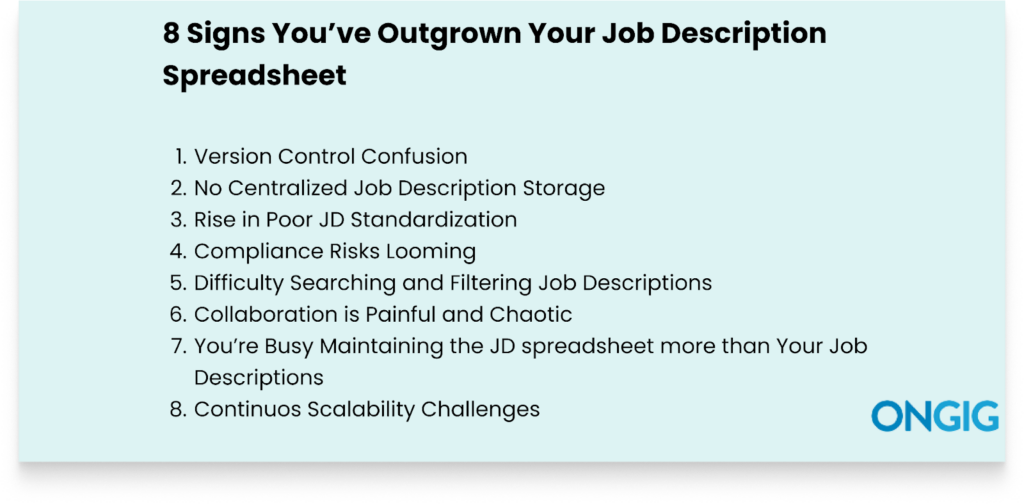
1. Version Control Confusion
You and your team members have probably found yourselves in situations where you’re wondering which job description version document to work on. For instance, let’s say you want to check the final job description document for a product designer role in your organization. You’ll probably find more than five different files with confusing names such as product designer_JD_final_.xlsx, designer_JD_revised_final_.xlsx, designer_JD_final_edited.xlsx, e.t.c.
Plus, you’ve also probably found yourselves in situations where you’re wondering why critical job description elements were not added in a certain JD document.
And this is because a job description spreadsheet creates version control chaos, leading to you working on outdated JD versions. This then leads to conflicting edits, producing JD duplicates, and struggling to merge all the changes.
In the end, your team wastes productive time they could have used for other HR tasks.
How Job Description Software Helps
Job description management software allows advanced Version Control capabilities that enable your team to create, track, revise, and edit all your JD versions in one place. For instance, you get:
- JD Version Comparisons: The software provides a comprehensive overview of your different JD versions. So you understand what got edited and the reasons for the edits. You can also see the person who made the changes and the time the edits were made.
- Cloud-Based Live JD Creation: With a JD software, you don’t have to manage different duplicate files in your job description creation and editing journey. Because every team member works on the same real-time JD document.
- Organized Approval Workflows: An efficient JD workflow process creates a proper approval process. This eliminates any JD version confusion.
- Restoration Capabilities: Easily restore the correct JD version if you’ve made any accidental changes. With this functionality, you won’t start writing your JD from scratch each time you accidentally lose the document.
This process saves your team many hours they would have wasted finding the correct job description document.
2. No Centralized Job Description Storage
With a job description spreadsheet, your JDs lack a centralized storage library. And locating what you want becomes a challenge. In the end, you experience more challenges, such as:
- Spending hours trying to locate the right JD version
- Creating duplicates of JDs
- A chaotic collaboration process
- Poor JD standardization
- JDs lacking critical components
- Looming compliance challenges
Plus, with your JDs scattered everywhere, you can’t examine your recruitment process to identify which areas need improvement.
How Job Description Software Helps
A job description software provides a centralized library that helps in:
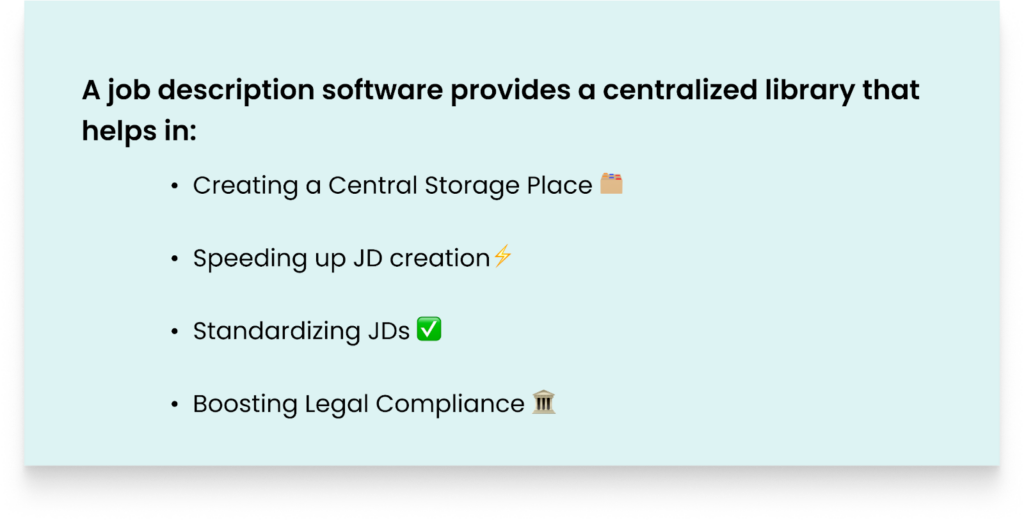
- Creating a Central Storage Place: The tool builds a centralized cloud storage where every team member can access job descriptions with the right access control. So there are no scattered JDs. And all the versions of JDs are up to date.
- Speeding up JD Creation: Easily retrieve a library of previous approved job descriptions and use them as inspiration when you’re writing your JD instead of starting from scratch. You can also use relevant components from the previous JDs as your foundation to save time.
- Standardizing JDs: With a JD tool, you have access to customizable job description templates that make it easier to check if all the JDs follow standardized formats, language, and content guidelines.
- Boosting Legal Compliance: JD platforms simplify the creation of pre-approved content libraries and templates that have critical legal elements. Thus making it easy for your team to build compliant JDs
3. Rise in Poor JD Standardization
A job description spreadsheet doesn’t provide capabilities to enhance standardization across job descriptions. For instance, the spreadsheet doesn’t make it easy to lock in mandatory fields for consistency across all JDs, like EEO statements or organization values.
So, you produce inconsistent JDs that ruin your employer brand and voice.
Also, a spreadsheet doesn’t highlight outdated JD details. For example, if a JD still lists outdated compliance guidelines, you won’t get an alert unless you start manually sifting through your database of JDs.
How Job Description Software Helps
A job description tool improves the standardization of your JDs through these approaches:
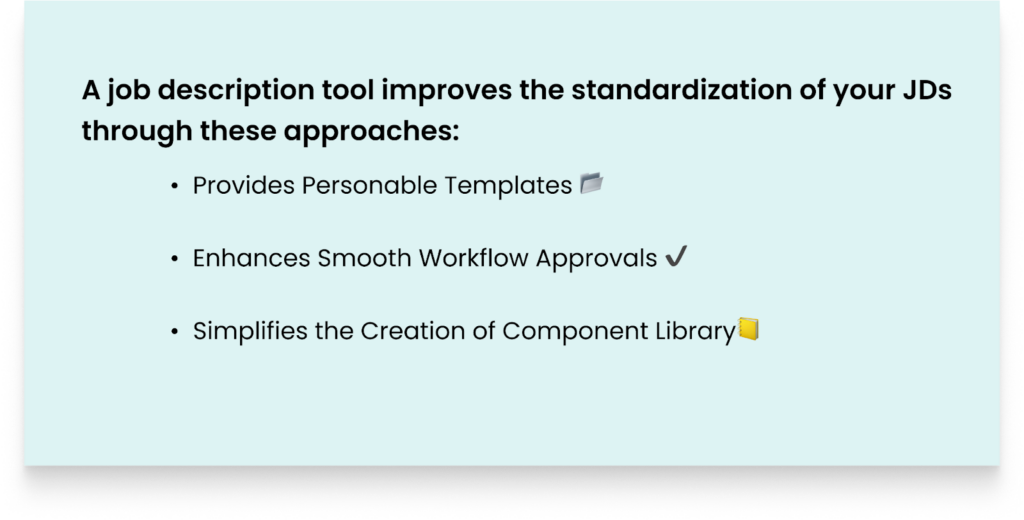
- Provides Personable Templates: The platform offers customizable templates to create a consistent JD with all important sections, such as salary range, responsibilities, job title, benefits, organization values, and mission.
- Enhances Smooth Workflow Approvals: The simplified approval process ensures that everyone focuses on their designated tasks, streamlining the workflow. Plus, there’s a proper structure in place. This way, there’s auditing of the JD before it’s published, to ensure good JD standardization.
- Simplifies the Creation of Component Library: Your team can quickly build and maintain libraries of pre-approved content templates for common JD elements. For instance, they can create a content template for the company boilerplate. This way, you have consistent descriptions of your company’s mission across all JDs.
4. Compliance Risk Looming
When it comes to recruitment, compliance isn’t a nice-to-have factor. It’s a critical requirement.
But the unstructured nature of a job description spreadsheet exposes your organization to compliance issues.
For instance, a spreadsheet may allow unauthorized edits to essential JD language. This issue might go unnoticed until the JD goes live, as a spreadsheet doesn’t make it easy to build a proper JD approval process.
So anyone on the JD writing team can edit any section they want, including compliance-sensitive sections such as EEO statements.
Plus, with spreadsheets, it’s challenging to track who made certain changes, the timeline changes, and the reasons for the JD changes. So if JD compliance-related suits arise, you won’t have an audit trail to defend your case.
How Job Description Software Helps
A job description platform prevents compliance risks in your organization through some of these methods:
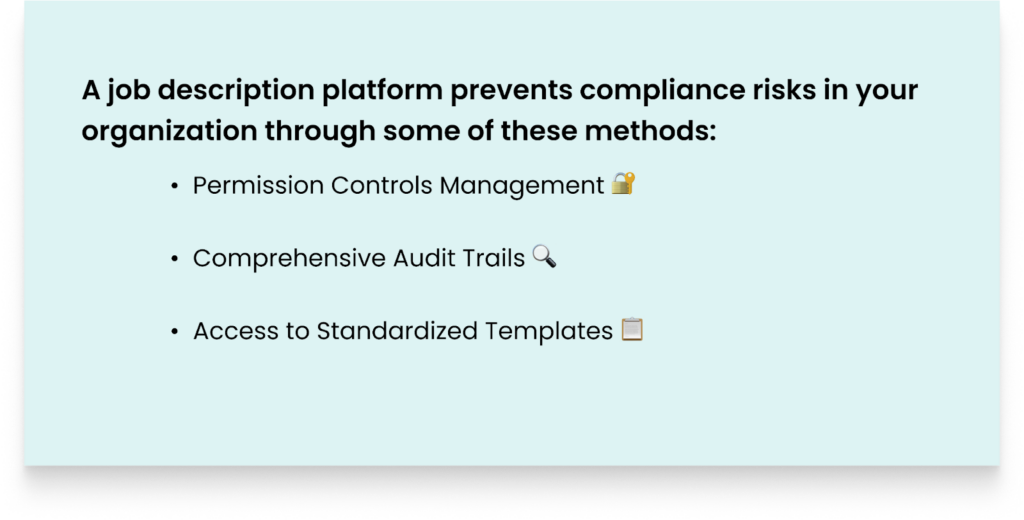
- Permission Controls Management: The platform provides “management control” to ensure that not just anyone can edit what they want in the JD document. This prevents any unwanted changes to critical JD language.
- Comprehensive Audit Trails: The platform provides a visual representation of the entire JD document creation journey. You can monitor all changes, timeline changes, and see who made the edits. Plus their reasons for the changes.
- Access to Standardized Templates: You have access to customized templates that have compliant required sections, such as EEO statements, and pre-approved language. These templates ensure you have a solid JD-compliant foundation process.
5. Difficulty Searching and Filtering Job Descriptions
A job description management process sometimes requires:
- Searching for old job descriptions to use as an inspiration or template.
- Finding job descriptions for a specific role, seniority status, and department.
- Searching JDs to know which ones require critical updates.
- Searching and assessing JDs to support ongoing talent strategy objectives and workforce planning.
But all this searching and filtering isn’t possible when using a job description spreadsheet. The spreadsheet offers basic search and filter functionalities that can’t manage a comprehensive job description management process. With a spreadsheet, you can’t filter JDs by job title, position level, specific department, or salary range.
And there’s no way to build a system to organize your JDs so you can find any job description you want in minutes. You’re left with a limited text search capability in the JD document.
How Job Description Software Helps
Job description platforms such as Ongig provide advanced search and filter functionalities that help you locate your JDs through job titles, salary range, skills, or specific departments by entering relevant keywords.
This way, it’s easy to compare your JDs. Use some JDs as templates, and evaluate the requirements for different open positions.
Plus, you easily check which JDs require critical updates. And as your organization’s JDs demand increases, search and filter functionalities guarantee efficient scalability of your system.
In the end, this frees up your team’s productive time to do other important tasks instead of continually sifting through a huge database of JDs.
6. Collaboration is Painful and Chaotic
At first, writing job descriptions using a spreadsheet feels like you’re doing proper teamwork.
After all, everyone has the job description spreadsheet link and can edit the document at any time.
But, as you continue hiring and your JD description volume needs increase, you realize that this “collaborative spreadsheet” is actually contributing to rising miscommunication, duplicated work, and version control chaos.

Image Source: Unsplash
For instance, you’ll realize your team is constantly running into issues such as:
- Disorganized Email Feedback Loops: The lack of a central structure for communication brings an endless email feedback loop. And there’s no easy way for each team member to view and submit their feedback for quick access.
- Overlapping JD Edits: Since there’s no central JD creation system, everyone makes the edits they want without realizing that these edits conflict with what the JD aims to achieve.
- Delay in JD approvals: Job description spreadsheets create frequent confusion in JD approvals. Anybody can approve whichever JD they want. As a result, the HR team ends up publishing the job description late.
How Job Description Software Helps
Job description management software, such as Ongig, enhances efficient collaboration and communication in various ways, such as:
- Provides a Real-Time Feedback Medium: Ongig prevents the disorganized feedback process by ensuring everyone involved in writing the JD submits feedback on time and in a single platform.
- Enables Position-Based Access Collaboration: Ongig makes it easy for everyone writing the JD to have specific permissions. This way, there’s an order on who is supposed to work on what tasks.
- Simplified User Management Process: Ongig also makes it easy to set an “Administrator” control to oversee the user accounts and easily add any new team members to the platform. This way, the administrator can quickly add anybody who’s needed to either edit or write a particular JD section.
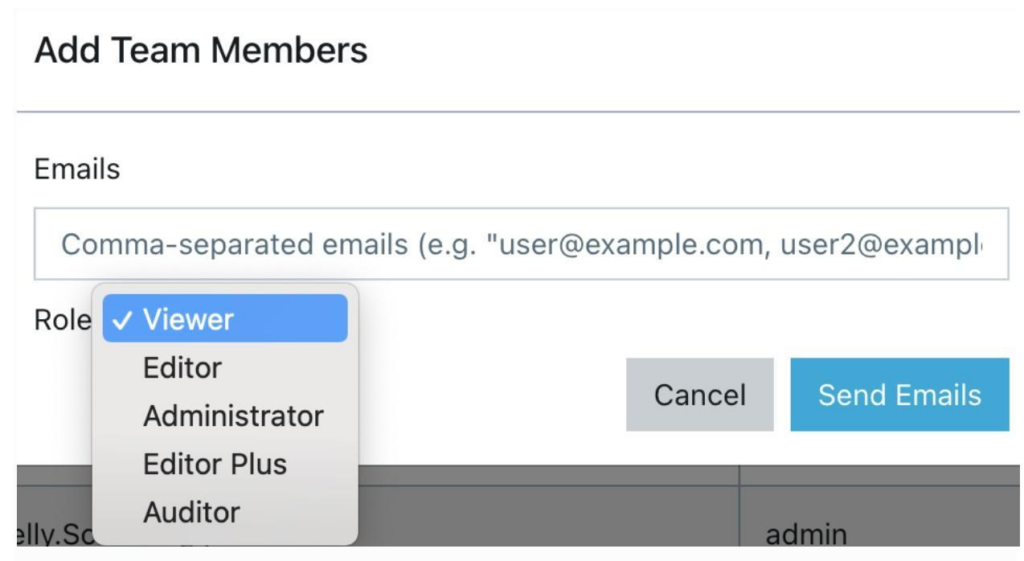
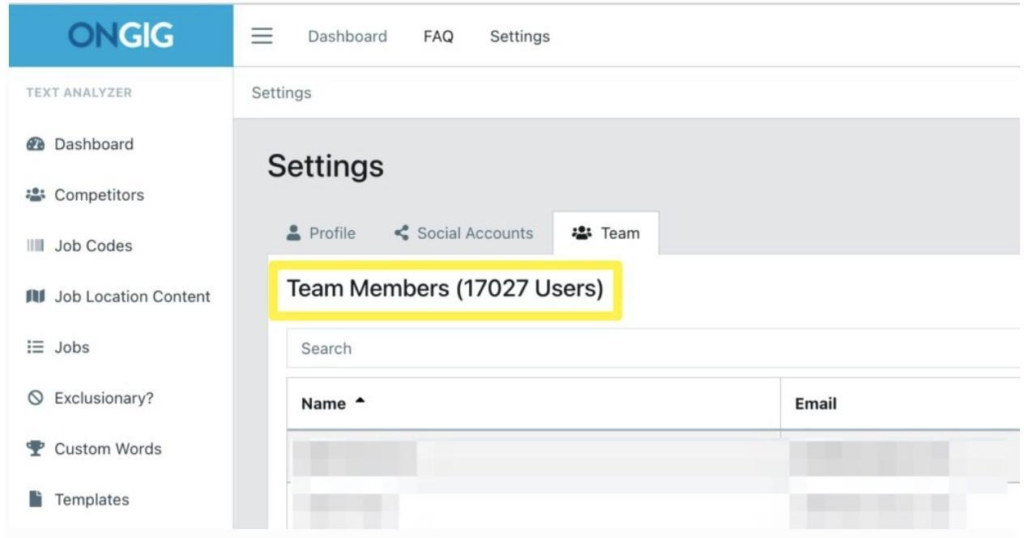
7. You’re Busy Maintaining the JD spreadsheet more than Your Job Descriptions
With a spreadsheet, your focus shifts from creating good job descriptions to managing the spreadsheet itself. Here’s how:
- Constance maintenance and formatting: You’re always trying to boost the readability of the spreadsheet by manually adjusting columns and arranging different confusing tabs.
- Version Control chaos: Each time you’re organizing, renaming, and looking for the correct JD document.
- Manual data entry repetition: A spreadsheet forces your team to do repetitive work. For instance, every new data entry needs to be manually entered across different sheets, columns, and tabs.
- Many error correction phases: Any mistake in a job description spreadsheet is a headache. And tracing and fixing it takes many hours that your team would have spent doing other valuable work.
All these errors lead to a rise in productive time wastage.
How Job Description Software Helps
Simply put, a job description platform frees your team from administrative work and helps them focus solely on strategic job description tasks. Here’s how:
- It automates any tedious and manual job description tasks.
- The platform manages any technical maintenance automatically. You don’t have to deal with any slow tools and formatting headaches.
- It enhances efficient integration with your applicant tracking systems. So you don’t waste time doing manual data entry.
- The tool provides efficient version control capabilities. This way, you don’t waste time tracking the correct JD document.
- The software puts error prevention practices in place. You won’t find yourself struggling with continuous fixes like with a spreadsheet. For instance, the software makes it easy to set approval workflows to ensure your team catches any issues before they mess up the JD creation process.
8. Continuous Scalability Challenges
A job description spreadsheet works well when your team is only working with a few job descriptions. But it becomes a hurdle as your organization grows and the demand for JDs rises. Here’s how:
- Continuous System Crashes: A spreadsheet can’t handle the editing of a huge volume of JDs. This process wastes your team’s time because they can’t create JDs comfortably without frequent system challenges.
- Challenging to Hire Globally: With a spreadsheet, it becomes difficult to manage JDs for the same open positions in different nations. For instance, you won’t know how to handle the unique legal requirements of the open positions because you’ll find yourself buried in different spreadsheet columns that are confusing to navigate.
- Siloed JD Integration: With a spreadsheet, your data is disconnected from your other HR systems. This means every time you’re hiring, you’re continually manually inputting data. And this becomes tiresome when you’re hiring for many roles.
How Job Description Software Helps
Job description platforms handle a job description management process without any challenges. Here’s how:
- Cloud-Based JD Storage: With a JD repository tool, your JDs get centralized storage. You can access and manage the JDs anytime you want. And it doesn’t matter what the number of JDs you’re handling is, even if it’s 5000, the system doesn’t crash.
- Bulk Editing Capabilities: Your team can quickly edit a huge volume of JDs without encountering any system crashes.
- Provides Customized JD Templates: Since your organization is growing, you don’t have to start writing your JDs from scratch each time because the tools provide templating functionalities to save you time.
- Manages JD Creation Complexity: The platforms make it easy to hire globally. They can manage localization and the different needs that each department wants included in the JD. Plus, the creation of an efficient workflow process ensures that a JD for any region gets published without any errors.
So with a JD platform, you won’t always live with the worry that your system will crash each time, like when you’re using a JD spreadsheet.
3 Tips for Making a Transition to Specialized Job Description Software
Before making your transition from a job description spreadsheet to a JD software, pay attention to these important factors:
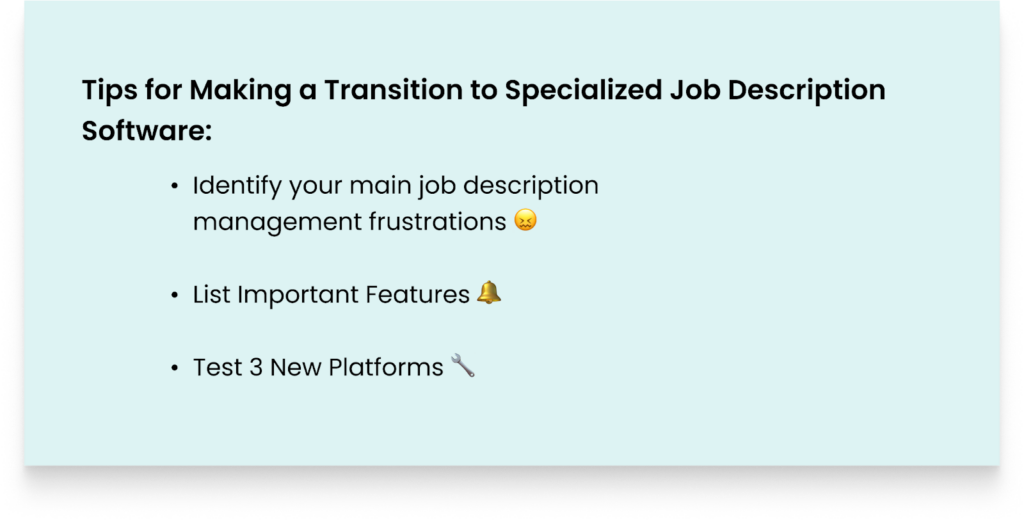
- Identify your main job description management frustrations: Without identifying your key JD management challenges, you’ll get software that will frustrate you like the previous spreadsheet. So with your team, note down the main frustrations you’ve experienced frequently.
- List Important Features: Based on the frustrations you’ve listed, create a list of the must-have features from any tool you might select. This way, you’ll get a platform that can eliminate all your key challenges.
- Test 3 New Platforms: After identifying the platforms that can solve your JD frustrations, do a pilot test of 3 tools to identify the efficient one. Most tools provide free trial periods to help you understand if their product can help you.
- Team Training: Ensure your vendor provides training to your team to understand how to use the software so you and your team get the maximum value. This way, you won’t be paying for important features that your team hasn’t even learned how to use.
After a period of 6 months, do an audit to identify if you’re getting any value from the new software. For instance, check if the platform has managed to minimize your key job description creation challenges.
FAQs: Signs You’ve Outgrown Your Job Description Spreadsheet
- Can I Import My Old Job Descriptions from Spreadsheets?
Yes, you can easily import your JDs from spreadsheets to your preferred job description software. Most JD software tools have different methods of helping you import your JDs to their software.
- Will Job Description Software Help with Compliance?
Yes, job descriptions manage compliance issues through different methods such as inclusive language guidance, automated employment laws updates, and ensuring a lock functionality for compliance essential JD sections such as EEO statements.
- How Much Time Will I Save by Ditching Spreadsheets?
The estimated time saved varies based on your job description needs. But by eliminating the stress and manual work of managing a spreadsheet, you’re sure you’re saving many hours. For instance, you can find that you’re saving 50% of the time you used to waste on version control issues with spreadsheets.
- Is JD Software Expensive?
JD tools aren’t expensive considering how they simplify your job description management process. But the price of the tools depends on the product you choose and the payment options you select.
- Can Multiple Team Members Collaborate in Real-Time?
Unlike JD spreadsheets, where communication happens in silos, JD software enables your team to create an efficient collaboration process. All communication happens in real-time and in one central place.
Why I Wrote This
If you’re still using a JD spreadsheet, I’m sure you recognize the signs above. And that means it’s time to organize your JD process with a specialized JD software such as Ongig. With Ongig, you eliminate all version control headaches, collaboration challenges, rising compliance issues, JD standardization inefficiency, and more.
So if you’re ready to ditch your JD spreadsheet, book a demo with us today. We’d be glad to show you how it works.
